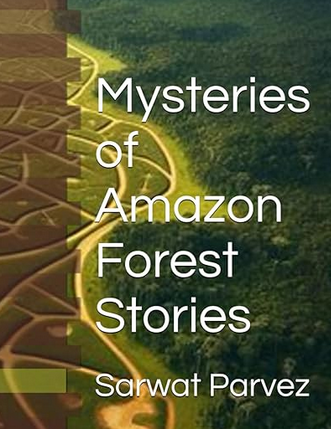Mysteries of Amazon Forest Stories

Mysteries of Amazon Forest
Stories
Contents
1. Introduction. 3
2. Story 1. Story of La Malinche (Malinalli). 11
3. Story 2. El Mano, Dee Mano, and Fi Mini. 21
4. Story 3. The love story of Fi Mini and Dee Mano. 36
5. About the Author.89
Introduction
The Amazon Forest, a vast expanse of biodiversity and enigma, holds within its green embrace a myriad of mysteries that have captivated the human imagination for centuries. From the unexplained geoglyphs, vast geometric earthworks carved into the landscape thousands of years ago, to the tales of lost cities like El Dorado that have lured explorers and adventurers into its depths, the Amazon is a treasure trove of historical puzzles.
The forest's layers, from the emergent canopy to the shadowy forest floor, are home to an astonishing variety of flora and fauna, some yet to be discovered or fully understood by science. The recent uncovering of ancient "Amazonian dark earth," a testament to the ingenuity of pre-colonial societies who enriched the soil with sustainable practices, reveals a history of sophisticated land management and hints at a once-thriving network of indigenous settlements. As deforestation unveils more of these secrets, it also threatens the forest's future, with over 17 percent lost in the last fifty years. Yet, amidst these challenges, the Amazon continues to be a source of wonder, its mysteries a siren call to the curious and the brave.
The geoglyphs of the Amazon Forest are a fascinating enigma, etched into the earth over centuries, their true purpose lost to time. These enormous geometric earthworks, some as wide as 36 feet and as deep as 13 feet, were constructed between 2000 and 650 years ago, suggesting a long history of human interaction with the Amazonian landscape. The discovery of these geoglyphs in the Brazilian state of Acre was a byproduct of deforestation activities, which, while destructive, have inadvertently peeled back layers of history, revealing the intricate designs that lay hidden beneath the forest canopy for millennia.
The geoglyphs' designs vary from simple circles and squares to complex octagons, hinting at a sophisticated level of organization and purpose among the ancient Amazonian societies. Despite their grandeur, the geoglyphs are not surrounded by significant artifacts that could suggest they were residential areas or defensive structures. Instead, it is believed they served as ceremonial or ritual sites, places for gathering, perhaps reflecting the cosmology and social structure of their creators.
What's particularly intriguing is that these structures were not built in untouched landscapes but in areas already modified by human hands. Charcoal layers found in the soil indicate that controlled burns were used to clear areas, a practice that points to a form of land management and suggests that the Amazon was not the 'untouched wilderness' as often portrayed but a region shaped by human ingenuity for thousands of years.
The presence of bamboo-dominated forests, resilient to both climate change and human activity, further supports the idea of a symbiotic relationship between the ancient Amazonians and their environment. This relationship is evidenced by the "Amazonian dark earth," fertile soil that was likely enriched through sustainable practices by pre-colonial societies, showcasing a deep understanding of land management that rivals modern techniques.
As we continue to uncover more about these geoglyphs, they challenge our perceptions of pre-Columbian Amazonia, painting a picture of a landscape that was carefully curated by its inhabitants.
The geoglyphs stand as a testament to the complex societies that once thrived in the Amazon, their legacies etched into the earth, waiting for us to unravel their stories and learn from the ancient wisdom they hold.
They remind us that the Amazon, as much as it is a natural wonder, is also a cultural heritage site, rich with human history and deserving of our respect and protection. The mysteries of the geoglyphs are not just puzzles to be solved but are keys to understanding the sustainable practices of the past that could inform our future.
Story 1
Story of La Malinche (Malinalli)
La Malinche, born Malinalli, was a figure of great significance and complexity in the history of Mexico. Her story is one of resilience, intelligence, and survival in the face of immense change and adversity. Born around 1500 into a noble family in a region influenced by the Mayan and Aztec empires, Malinalli was named after the goddess of grass, reflecting her noble roots. However, her life took a dramatic turn when she was sold into slavery as a young girl, a common practice at the time.
Despite the hardships of slavery, Malinalli's linguistic abilities flourished as she became fluent in the languages of the Mayan and Aztec peoples, as well as the prestigious Nahuatl language of the courts. Her skills would soon prove invaluable. In 1519, the Spanish conquistador Hernán Cortés arrived in the Yucatán Peninsula, and Malinalli, known by then as La Malinche, was among the enslaved women given to him as a peace offering by the local leaders.
La Malinche's linguistic prowess quickly caught Cortés' attention, and she became his interpreter, advisor, and intermediary with the indigenous peoples. She played a pivotal role in the Spanish conquest of the Aztec Empire, facilitating communication and negotiations between Cortés and the indigenous leaders. Her ability to speak multiple languages, including Spanish, allowed her to bridge the vast cultural divide between the two worlds.
Her relationship with Cortés was complex; she was at once his captive and his confidante, and some accounts suggest she bore him a son. La Malinche's role in the conquest has led to her being a controversial figure in Mexican history, seen by some as a traitor and by others as a victim of her circumstances. Her story is a testament to the turbulent times in which she lived and the difficult choices she faced.
La Malinche's legacy reflects the broader historical narrative of colonization and resistance. She is remembered as a symbol of cultural synthesis, embodying the fusion of indigenous and Spanish influences that would come to define the Mexican identity. Her story challenges us to consider the nuanced and often conflicting facets of historical figures, and to recognize the profound impact that individuals can have on the course of history.
In modern times, La Malinche's story continues to resonate, sparking debates about identity, loyalty, and the legacy of colonialism. Her life is a reminder of the complex interplay of power, culture, and language, and the ways in which individuals navigate these forces. La Malinche remains an enduring figure in Mexican history, her story narrative rich with lessons about resilience and the human spirit.
After the tumultuous Spanish conquest, La Malinche's life entered a quieter phase, yet it remained intertwined with the Spanish presence in the New World. She continued living with Hernán Cortés and bore him a son named Martín in 1522, often considered one of the first Mestizos, embodying the mixed indigenous and Spanish heritage that would characterize much of Latin America.
La Malinche's relationship with Cortés was multifaceted; she was his interpreter, advisor, and the mother of his child, but also a symbol of cooperation and conflict between two worlds. Despite her critical role in the conquest, her life after these events is less documented, shrouded in the mists of history. It is believed that she married a Spanish hidalgo, Juan Jaramillo, which would have been a strategic alliance, securing her position and future in the colonial society.
Her later years are not well recorded, but it is known that she had a daughter with Jaramillo, further contributing to the new cultural and genetic lineage. La Malinche's legacy is complex; she is remembered in various lights, as both a traitor and a survivor, a victim and a bridge between cultures. Her story has been reinterpreted through the ages, reflecting the evolving understanding of her role and the broader consequences of the conquest.
The narrative of La Malinche is a poignant reminder of the human dimension in historical events. Her life encapsulates the themes of adaptation, resilience, and the blending of cultures that are still relevant today. As the mother of a new generation, her personal story is a microcosm of the larger story of Latin America itself, a region marked by the confluence of indigenous and European influences.
La Malinche's story does not end with her death; it continues to be told and retold, each iteration exploring different facets of her identity and choices. She remains a figure of enduring fascination, a woman who navigated the treacherous waters of early colonial politics with grace and intelligence. Her legacy is a testament to the complex and often painful birth of the modern Americas, and her life a narrative that challenges us to consider the shades of grey in our interpretation of history. Through her, we can explore themes of power, agency, and identity, and the ways in which individual lives can shape the course of empires. La Malinche, a woman of her time, became a timeless symbol of the intricate tapestry of human history.
La Malinche's children, Martín Cortés and María Jaramillo, are significant figures due to their mixed heritage, embodying the convergence of indigenous and Spanish lineages. Martín, born in 1522, was one of the first mestizos, a term used to describe individuals of mixed European and Indigenous American ancestry. His birth symbolized the new cultural and racial blend that would come to define much of Latin America. Martín's life was marked by his unique position as the son of Hernán Cortés, which granted him certain privileges and a notable status within colonial society.
Martín's later life was as eventful as his birth. He was sent to Spain for his education and returned to New Spain as a young man. However, he faced challenges due to his mestizo heritage, which placed him in a complex social hierarchy. Despite his father's prominence, Martín was not fully accepted by the Spanish elite. He eventually became involved in a rebellion against the Spanish crown, known as the Mixtón War, which sought to defend indigenous rights and land. This involvement led to his arrest and subsequent exile, highlighting the turbulent nature of post-conquest society and the struggles faced by those of mixed heritage.
María Jaramillo, La Malinche's daughter with her husband Juan Jaramillo, is less documented in historical records. However, her existence further illustrates the legacy of La Malinche as a mother to a new generation that bridged two worlds. María's life would have been shaped by the cultural shifts and complexities of early colonial Mexico, and she likely would have navigated the same intricate social landscape as her brother.
The fates of La Malinche's children reflect the broader narrative of the era, a time when identities were being forged and redefined in the aftermath of conquest. Their lives serve as a testament to the enduring impact of their mother's legacy, as they lived at the intersection of the old and the new, navigating a world that was forever changed by the events in which La Malinche played a pivotal role. Through her children, the story of La Malinche continues, their lives a continuation of the cultural and historical tapestry she helped weave. They stand as living embodiments of the fusion of cultures that La Malinche herself represented, and their stories, though not as widely told, are an integral part of the rich mosaic of Latin American history. Martín and María are not just the offspring of a historical figure; they are the personification of a cultural evolution, the human face of a transformative epoch in the Americas. Their lives, their challenges, and their legacies reflect the complex interplay of power, identity, and heritage that has shaped the continent's past and continues to influence its present and future.



